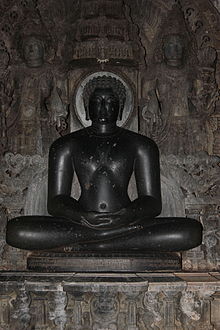Shantinatha
Shantinatha or Shantinath is the 16th of a total of 24 Tirthankaras of the Jaina religion ; its name contains the Sanskrit word shanti (शान्ति śānti), which can be translated as “peace”, “inner silence”, “rest of the senses” etc. His biography is recorded in Shāntinātha Charitra, written around 1250 - a work that has been recognized by UNESCO as a written cultural heritage of mankind .
myth
Before his last reincarnation, Shantinatha had been reborn eleven times as god or demigod; last he was born in Hastinapur as the son of the Ikshvaku King Visvasena and his wife Achira . He ascended his father's throne at the age of 25,000 and was considered the ideal ruler of the world ( chakravartin ) and lover ( kamadeva ). At the age of 50001 he decided to become a Jain monk and repent, which enabled him to rid his soul of all karma .
Representations
Among the 24 Tirthankaras, Shantinatha is one of the most popular; there are correspondingly many temples with seated (= meditating) or standing (= atoning) representations. Like all tirthankaras, these are completely naked; her eyes are wide open and there is a jewel on her chest. His companion or pack animal ( vahana ) is a deer or a doe.
Adoration
Shantinatha is worshiped by the Jain religion all over India. The most famous sanctuaries are located in the Jain temple complexes of Mount Abu and Chittorgarh (Rajasthan), Khajuraho (Madhya Pradesh) and Deogarh (Uttar Pradesh) .
See also
literature
- Kristi L. Wiley: The A to Z of Jainism. Scarecrow Press 2009, ISBN 978-0810868212
Web links
- Discovery of a Shantinatha figure in Rohatak, Pakistan - Photo + info (English)
- Shantinatha figure in Mumbai, India - photo + brief information (English)

